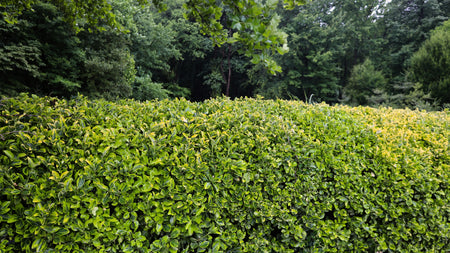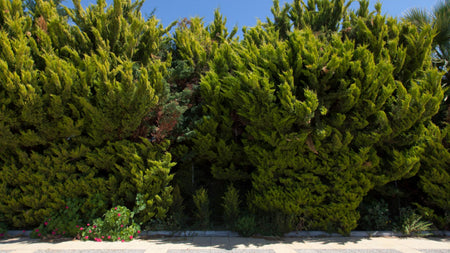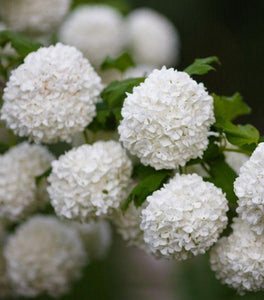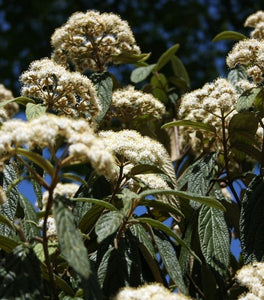
Images Depict Mature Plants
Chindo Viburnum for Sale Online
The Chindo Viburnum is a fast-growing evergreen shrub known for its glossy, dark green foliage and dense, upright growth habit, making it an excellent choice for privacy hedges or screening. Reaching a mature height of 12-15 feet and spreading 8-10 feet wide, this hardy shrub provides year-round interest and structure to any landscape. Its leaves are thick and leathery, offering a beautiful contrast with the clusters of small, fragrant white flowers that bloom in late spring, followed by vibrant red berries that transition to black as they mature. Hardy in USDA Zones 7-9, Chindo Viburnum thrives in warm climates and can tolerate a variety of growing conditions.
Ideal for both residential and commercial landscapes, Chindo Viburnum performs best in full sun to partial shade and well-drained soil. Its rapid growth rate makes it perfect for creating a lush, natural screen in a short amount of time. Once established, it is drought-tolerant and requires minimal care beyond occasional pruning to maintain its desired shape. In addition to its ornamental value, Chindo Viburnum is also a deer-resistant shrub, which helps preserve its foliage in areas prone to deer browsing.
Whether planted as a privacy hedge, a specimen plant, or as part of a mixed border, Chindo Viburnum adds year-round beauty and texture to the landscape. Its combination of dense foliage, fragrant flowers, and ornamental berries makes it a versatile and attractive choice for a variety of garden designs. With minimal care requirements and a robust growth habit, Chindo Viburnum is a practical yet visually appealing solution for creating privacy or adding evergreen structure to your garden.

| Hardiness Zone: | 7-9 |
|---|---|
| Mature Height: | 12 to 15 feet |
| Mature Width: | 8 to 10 feet |
| Classification: | Broad leaved evergreen shrub, spring flowering |
| Sunlight: | Full sun to partial shade |
| Habit: | Spreading, densely branched |
| Foliage: | Dark green |
| Flower Color: | White |
| Pruning Season: | Prune in late winter, flowers on new wood |
| Soil Condition: | Any well drained soil |
| Water Requirements: | Water well until established. |
| Uses: | Extremely attractive when used as a focal point in the mixed border, mass planting, or a specimen planting |
How to Care for Chindo Viburnum
Make sure to read about the recommended care instructions to keep Chindo Viburnum healthy and thriving for years to come!
How Do I Plant A Chindo Viburnum?
To plant a Chindo Viburnum, start by selecting a location with full sun to partial shade and well-drained soil. This fast-growing shrub thrives in USDA Zones 7-9 and performs best in areas with at least 4-6 hours of sunlight daily. Dig a hole twice as wide and just as deep as the root ball to give the roots plenty of space to spread. Place the Chindo Viburnum in the hole, ensuring the top of the root ball is level with the ground, then backfill with a mixture of native soil and compost to improve nutrient availability and drainage. After planting, water deeply to help the roots establish and apply a 2-3 inch layer of mulch around the base to retain moisture and regulate soil temperature. Once planted, water your Chindo Viburnum regularly during its first growing season, especially during dry spells, to promote strong root development. Space the plants about 5-8 feet apart if you're creating a hedge or privacy screen, allowing room for their mature size, which can reach 12-15 feet in height and 8-10 feet in width. Regular watering, especially in the early stages, and the application of mulch will help maintain soil moisture and prevent competition from weeds. With proper planting and care, your Chindo Viburnum will quickly grow into a beautiful, dense hedge or standalone shrub, adding year-round structure and interest to your landscape.
How Do I Water A Chindo Viburnum?
To properly water a Chindo Viburnum, ensure the soil remains consistently moist, especially during the first growing season. Deep watering once or twice a week helps establish strong roots and promotes healthy growth. Focus on watering at the base of the plant to ensure the moisture reaches the root zone, allowing the soil to stay moist but not waterlogged. In hot climates or during dry periods, you may need to increase the frequency of watering to prevent the soil from drying out completely. Adding a 2-3 inch layer of mulch around the base will help retain moisture, reduce evaporation, and keep the soil temperature regulated. Once your Chindo Viburnum is established, it becomes more drought-tolerant and requires less frequent watering. However, during prolonged periods of heat or dry spells, it’s important to continue deep watering to maintain the plant’s lush foliage and overall health. Avoid shallow watering, as this encourages surface roots, which are less effective at accessing water during dry conditions. Checking the top few inches of soil before watering can help ensure you provide the right amount of moisture, promoting a healthy and thriving Chindo Viburnum in your landscape.
How Do I Fertilize A Chindo Viburnum?
To fertilize a Chindo Viburnum, apply a balanced, slow-release fertilizer in early spring, just as new growth begins to emerge. A 10-10-10 or 12-6-6 fertilizer is ideal for providing the right balance of nutrients—nitrogen, phosphorus, and potassium—that support healthy foliage, strong root development, and overall plant vitality. Spread the fertilizer evenly around the base of the shrub, avoiding direct contact with the trunk, and water thoroughly after application to help the nutrients penetrate the soil and reach the roots. This spring feeding encourages robust growth and ensures the Chindo Viburnum maintains its glossy, evergreen appearance throughout the growing season. For continued nourishment, consider a second round of fertilization in mid-summer, especially if the shrub shows signs of nutrient deficiency or slow growth. You can also enrich the soil with organic matter, such as compost or well-rotted manure, which provides a natural source of nutrients. Be careful not to over-fertilize, as too much nitrogen can lead to excessive foliage growth at the expense of flower and berry production. With proper fertilization and care, your Chindo Viburnum will thrive, producing dense foliage and seasonal interest with its fragrant flowers and vibrant berries.

How Do I Prune A Chindo Viburnum?
To prune a Chindo Viburnum, the best time is in late winter or early spring before new growth begins. Start by removing any dead, damaged, or diseased branches to improve air circulation and overall plant health. Use clean, sharp pruning shears to make precise cuts just above a leaf node or outward-facing bud. If you're shaping the shrub or maintaining its height for use as a hedge, prune the outer branches lightly, keeping its natural, upright form intact. Avoid cutting too far into older wood, as this could reduce the shrub's ability to produce new growth. For ongoing maintenance, light pruning can be done throughout the growing season to remove any wayward or crossing branches and to keep the Chindo Viburnum looking neat and compact. If you're growing it as a privacy hedge or screen, trimming the sides and top will encourage denser growth, creating a fuller appearance. Regular pruning helps maintain the shrub’s shape and promotes healthy new growth, while also enhancing its flowering and berry production. With proper pruning, your Chindo Viburnum will continue to thrive and add beauty and structure to your landscape year-round.











